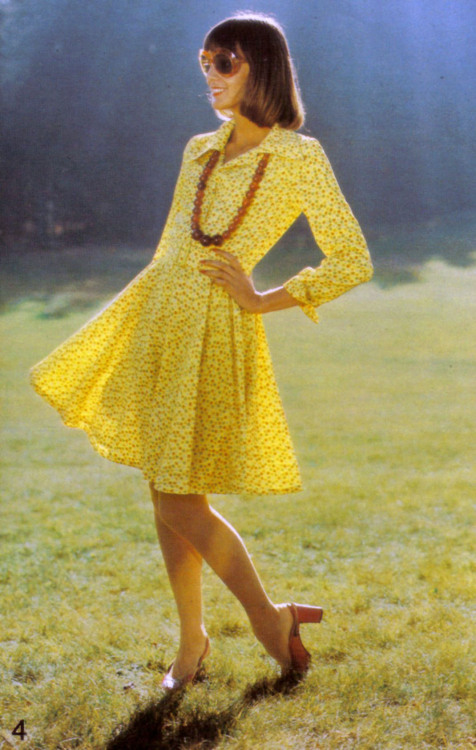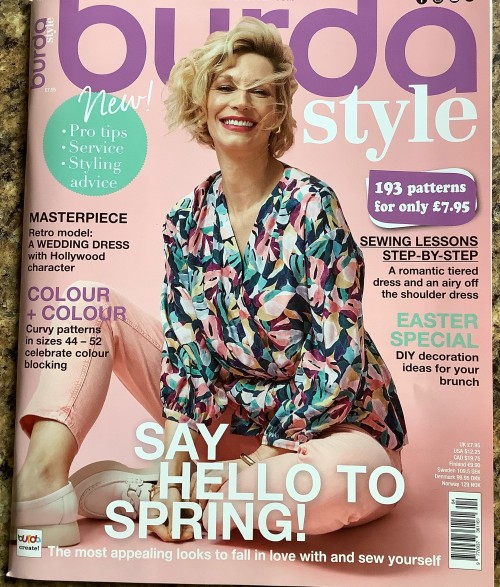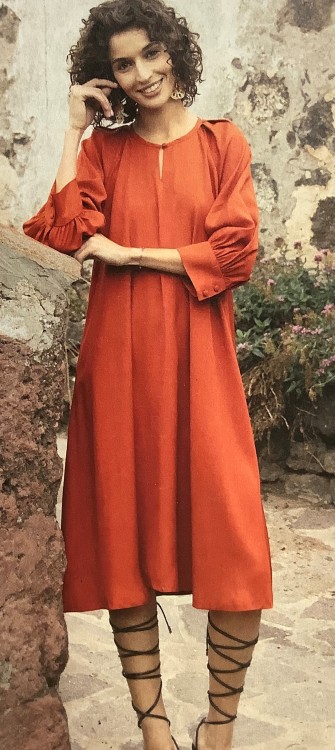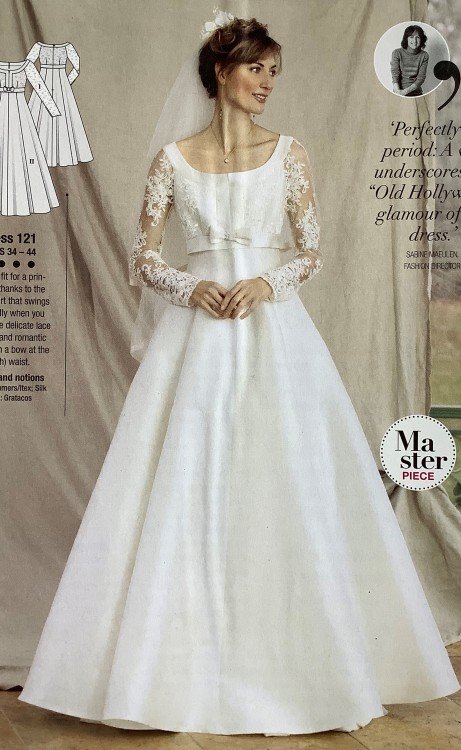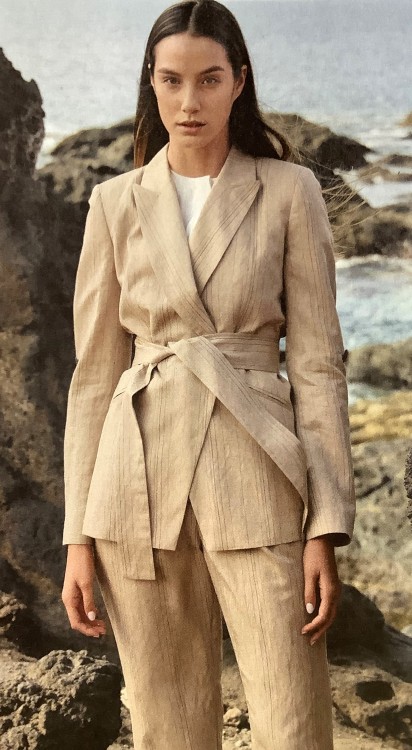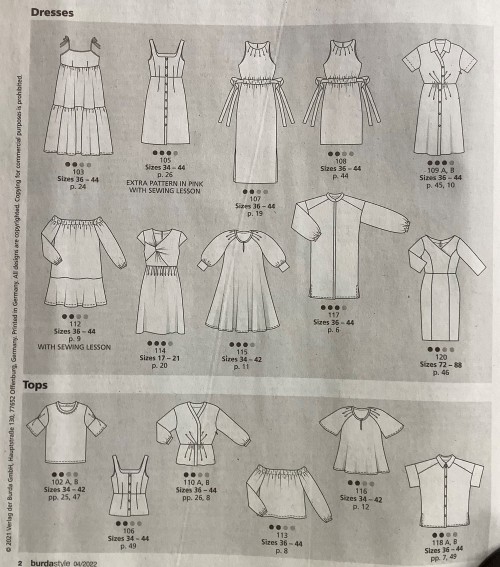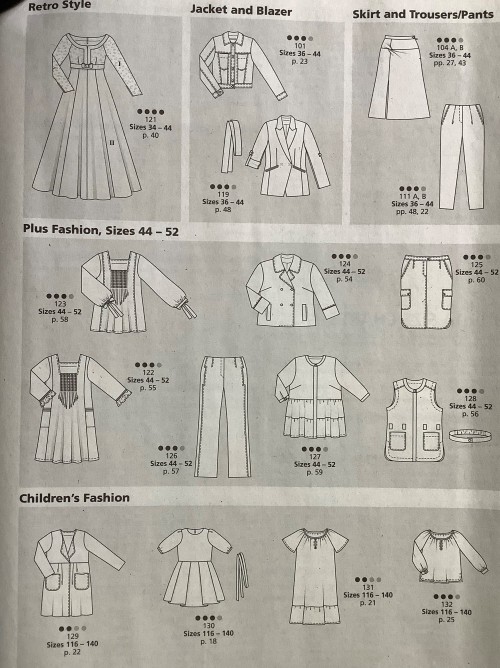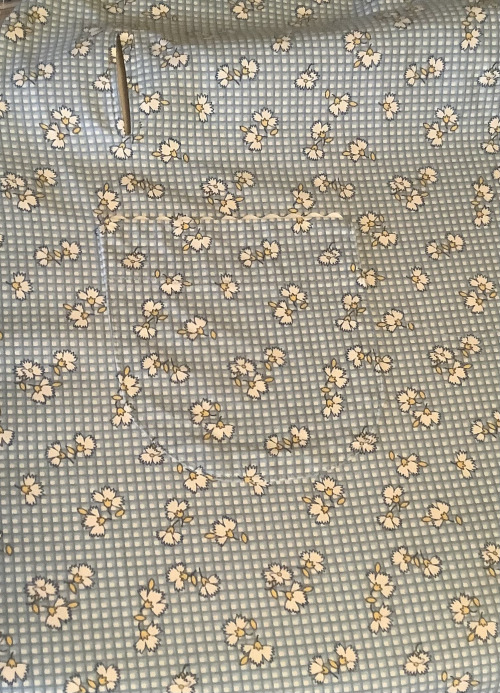#vintage sewing pattern

Next projects

And the 1940s pinafore is done!
The Big Reveal in the 1950s, Or Simplicity 9536
The reveal comes when you take off the bolero jacket and reveal the strapless dress beneath. Notice how the white, strapless version is clearly an important summer event. She has a flower corsage pinned to her belt and strappy, high heels. This fits with the fabric suggestion of taffeta, faille, or shantung which would have been made of silk. The blue and white version has straps and because it is gingham, it is not so daring in its appearance. Notice that the pink version has flat shoes too, an indication this might be a picnic or other low-key weekend event. This fits with the fabric suggestions of chambray, pique, seersucker or lightweight denim which would all be made of cotton.
This combination – bolero over revealing dress–was very common during the 1950s. It solved the problem of going out without revealing much until you got to your destination, or warming up when the evening turned cool. The bolero here is very simple. It has cut-on sleeves, little jaunty cuffs, a single buttons, and darts front and back to fit to the body. The dress is more complicated despite the “easy-to-sew” designation, as sign of a high level of home dressmaking skill at the time. Both the strapped and strapless version are supposed to be boned through the bodice, and both are trimmed with self-trim bias-cut fabric which is able to follow the curves of the neckline. The large pockets have fold-back flaps.
Of course, it was a look that was first popularized by Christian Dior in 1947, the New Look with soft shoulders, small waist, and long, luxurious flared skirts. The width of these skirts also indicates they were worn with a petticoat which fluffed out at the hemline. While lower calf lengths were the preference of Dior that year, the long skirts had crept up a inch by inch by the end of the 1950s. These fall a bit below the knee.
This is a re-issued pattern, so it comes in modern sizes. Find it at your local fabric store or online here: https://simplicity.com/simplicity/s9536
Post link
A Little of the Southwest: Simplicity 9538
Perhaps because there was such a big shift of population out west during World War II, perhaps because of movies set in the old west from Hollywood, and perhaps because of new attention to leisure wear, this kind of simple, gathered blouse associated with the Southwest became a fashion trend during the 1940s. The fabric suggestions include gingham and calico which are simple fabrics often worn by very young women, as well as challis which would drape more easily, and just plain cotton. This re-issued vintage pattern comes in modern sizes.
Often paired with a full gathered skirt, or a tiered gathered skirt, which are another very simple kind of garment, this kind of blouse was very ease to make. The sleeves are raglan and the only tricky thing is threading the ribbon or elastic through the neckline and sleeve edges. At the same time this simple pattern allowed a girl or young women a lot of design possibilities: mixing or matching colors for the ribbon and lace trim, adding ribbons or braid along the the bodice and sleeves.
The blouse also allows for two very different looks. See how they offered the black and white sketch to make makes clear that the ribboned version offers both an everyday look and a flirtatious off-the-shoulder look for evening.
Find it at your local fabric store or online here: https://simplicity.com/simplicity/s9538
This comes in modern sizes
Post link
BurdaStyle April 2022
It’s spring and this issue has a wide range of patterns as these images prove. From casual wear to a vintage wedding gown to work wear, there is a little bit for everyone.
The the cheery blouse on the cover 110 A,B, has its bodice opening off-center to the wearer’s left, but the peplum below opens at the center. It is lengthened and given buttons to appear as the shirt dress 109 A B.
The dress you see here is the raglan-sleeved 115 which is shown loose, perfect for a hot day, but could take a belt as well if you prefer. They made it in viscose which has drape and gives it a more slender silhouette as it falls close to the body.
The wedding gown Dress 121 dates back to 1957. It is fully lined, has a long, gored, flared skirt, a fitted bodice with scalloped lace overlay and then the lace alone for the sleeves. They suggest silk satin which is a traditional choice.
Then there is Blazer 119 whose front overlap goes off-center to the same degree below as the line of the lapel does above. It has welt pockets and buttons at the waistline, and can take its own wide belt.
This issue offers up 10 dresses, 1 in plus sizes; 3 blouses that aren’t shortened versions of the dresses with 1 in plus sizes; the gown; 3 jackets, 1 in plus sizes; 1 pair of pants in regular sizes and 1 in plus sizes, and 1 skirt in regular sizes and 1 in plus size; lastly, a vest in plus sizes. So 23 patterns for women, and then 1 coat and 2 dresses for girls, plus one shortened to a blouse. There are some diy table setting projects, and instructions on how to make roses out of bias strips of fabric (my tip: they are best in diaphanous, ombre fabrics).
You can find it at your local fabric store, newsstand, or bookstore, or here: https://www.burdastyle.com/subscription-burda-style/subscribe-to-burda-style.html?gclid=CjwKCAjwloCSBhAeEiwA3hVo_ZSCsbE17BNkzAWdNUkKVeiVHWrLOtHlfi_F70u0OPV4jpP7a3DZPBoCx7kQAvD_BwE
Post link
Aprons as Workwear and Fashion: Simplicity 9496
The aprons of earlier eras came out in an amazing assortment, various shapes, trims and edges. Lots of creativity was poured into designing and making them. Why? Because for most married women with children, aprons were their work wear because they were home women. Which meant they had to wear aprons everyday and who doesn’t enjoy some fashion variety? Here the variety is the color combinations and trims.
These aprons are from 1948. They all have some special feature, and the least detailed one is the one with stripes yet even then the stripes on the two pockets are cut exactly the same. No sloppy layout of the pattern pieces here. The red plaid has the most features, a pocket which matches the plaid lines of the apron, ruffles at the hem, and then baby rick rack as trimming at top, at hem, and on the pocket. They threw in the matching oven mitt padded with cotton batting and finished at the edges with double-fold bias tape. The other half apron takes a print and a solid to mix and puts the print for pockets and a band near the hemline. You can imagine a woman sorting through her box of cotton remnants looking for a nice color harmony to make this one.
Also notice how one model wears a navy dress and the other a blouse and skirt. There was no such thing as a t-shirt worn as outer clothing back then, and most women only wore pants for dirty work like gardening or painting, or for active sports. So the home woman would have been dressed in dress or skirt and blouse, and the apron would have served to keep her clean as well as cheerfully stylish.
You can find this pattern as a reissue at your local fabric store or here: https://www.simplicity.com/simplicity-storefront-catalog/patterns/brands/simplicity-sewing-pattern-s9496-misses-vintage-apron/
Post link
In Praise of Small Prints: Or the Bungalow Apron
I have blogged this dress before, but as I ironed it, I was thinking how much I admire the small prints on fabric of the past. The Dress Doctors always recommended them because they were easier to work with while dressmaking and they were not overwhelming to the average woman’s figure. This fabric was sold as a 1930s era reproduction.
See here how easy it was for me to match the print where the patch pocket was placed. There was almost no waste in cutting out the pocket either. Matching was otherwise a moot point where the ruffles at the neck and the tiers or flounce below and as a wrap, it made little sense to try to match along the opening edge.
Now if the flowers had been large, I would have had to think about where to place them so as to avoid the grotesque effect of two flowers over the breast or one landing at the crotch. And placing the pocket would have meant wasting fabric. I often am charmed with a print sold online, only to look at the photo with a ruler, realize the flowers are 3, 5 or even 7 inches across, and reject it.
I cannot decide if the textile designers like to work with larger prints, if large prints sell well because they look better on a small screen for web buyers, of if making smaller prints is more difficult in the manufacturing process. I do know that I will hold out for them.
You can find this pattern as a reproduction. It is a Hoover apron or bungalow dress, made famous during WWI when Herbert Hoover ran the government program on food conservation and the home economists designed an apron that wrapped and could be rewrapped when one surface became filthy. I know, kind of disgusting, but that was how it was made famous. Regardless of rewrapping, this makes for a nice summer robe, or even a casual daytime dress. Although wrapped dresses are not the most practical for wearing out of the house–fear the windy day–the length and amount of overlap makes it relatively secure.
Find it here: https://www.etsy.com/listing/220673334/1930s-ladies-hooverette-day-dress?ga_search_query=1889&ref=shop_items_search_2&sca=1
For many charming reproduction fabrics from the 19th and the 20th centuries, go here: http://www.reproductionfabrics.com/
Post link

